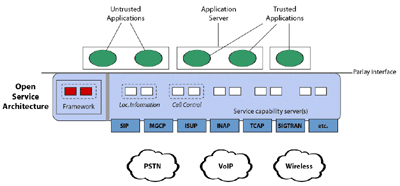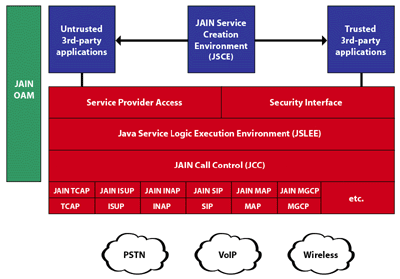IN SEARCH OF THE HOLY GRAIL OF SERVICE DELIVERY
"Faster, Better, Cheaper: Pick only two," the old saying goes.
Unfortunately, for service providers today, "only two" is not an
option. In fact, when it comes to services, service providers need four
out of four: More, Faster, Better, Cheaper. While competition for the
almighty telecom dollar continues to increase, prices for individual
services continue to decline. Now more than ever, service providers need
to be able to roll out more, interesting and valuable services, faster and
at a lower cost.
One area that opens the possibility for increased average revenue per
user (ARPU) is the delivery of content such as pictures and games over
wireless networks to mobile handsets. Another way to increase ARPU is
through added customization of existing services such as allowing
subscribers to provision follow-me services over a user-friendly Web
interface, or use the Web to enter a unique text display to be delivered
in lieu of a particular caller id. Additionally, service providers can
boost their revenues with services that may be short-lived such as
providing scores and highlights during a sporting event such as the
Olympics. There are many possibilities, however, service providers cannot
ignore the fact that while some services will be a big hit with consumers,
many more will flop. What service providers need is a way to roll out more
services, faster, better and cheaper with limited investment in the
underlying platforms.
The good news is that there are several initiatives well underway that
promise to enable the opening up of the telecom value chain, similar to
the way the revolution in the computer industry in the 1980s paved the way
for thousands of new, off-the-shelf applications. A common objective among
these initiatives is to create a framework that addresses the challenges
not solved in earlier attempts the industry made in search of streamlined
and integrated service creation for telecom networks. Some of these
challenges include integrating back-office and business functions with
services spanning a heterogeneous network consisting of wireline,
wireless, circuit and packet-based network elements, providing Web-enabled
customer access and allowing carriers to enable third-party content and
services over their networks. The industry is clearly endorsing the need
for standards-based service delivery platforms (SDPs) that meet these
objectives, as evidenced by the growing number of service providers and
vendors joining the consortiums aimed at specifying open telephony
standards and, more importantly, adopting the standards in their platforms
and applications. A few of the most promising initiatives are highlighted
in the sections below.
OSA/PARLAY
OSA/Parlay is a set of standard
Application Programming Interfaces (APIs) designed to provide application
developers with a high-level, standard interface to the functions provided
by telecom networks. The goal of the Parlay specifications is to foster
development of applications among enterprise and other third parties that
take advantage of the resources provided by a network without the
developer needing to know the low-level details. The application developer
accesses the function provided by the network through the Parlay
interface, which is implemented on a Parlay gateway. Not only does the
Parlay gateway shield the programmer from the network details, it also
protects the network from hazardous programming by the developer.
The Parlay gateway provides a common interface that mediates access to
the core network. This enables development of off-the-shelf applications
such as managing and charging for third-party content, routing
applications, location-based services and blocking and screening services.
Parlay APIs are technology-independent and network-independent.
Network-independent means that Parlay applications can be portable across
multiple types of networks: Wireline, wireless or packet-based.
Technology-independent means that Parlay does not specify anything about
how the APIs are implemented, such as the programming language, messaging
medium or operating system.
|

|
|
Figure 1 |
JAIN
The
objectives of the Java for
Integrated Networks (JAIN) initiative are similar to those of
OSA/Parlay: To simplify development of telecom applications and allow
applications to be written that are portable across any type of network
including wireline, wireless and packet. JAIN opens the opportunity to
develop applications for telecom networks up to the large community of
JAVA developers out there versus the rather limited community
of developers skilled in the complex, often proprietary, telecom
protocols.
|

|
|
Figure 2 |
The JAIN initiative
consists of two areas of API specification: The Protocol API
Specifications specify interfaces to wireline, wireless and IP
signaling protocols, and the Application API Specifications address
the APIs for creating Java services that used the network protocols. These
APIs cover areas such as call control, secure network access, service
creation and service execution.
Although
the goals of the JAIN and Parlay initiatives overlap (as well as some of
the APIs), the initiatives are quite complementary, and in fact the two
groups are collaborating. Since Parlay does not specify the technology or
the implementation below the service level APIs, JAIN can be used to
implement the Parlay APIs.
OSS/J
The
OSS
through Java (OSS/J) initiative defines and implements an open,
standard set of Java-based APIs for operations support systems (
OSS
). The overall goal is to foster a plug-and-play
OSS
market and produce end-to-end
OSS
solutions that support automated flow-through service fulfillment, service
assurance and billing. OSS/J does not define another generic
OSS
integration framework, instead the initiative leverages existing
Java-based component and container architectures and defines APIs that can
sit on top of new or existing
OSS
applications.
OSS/J has been mapped to the TeleManagement Forum�s Next
Generation OSS (NGOSS) Roadmap specification. In this aspect, OSS/J is a
technical realization of the thousands of hours the TM Forum has put into
developing the technology-independent framework.
INHIBITORS
TO DEPLOYMENT
Despite
the progress made toward defining and implementing carrier-grade telecom
SDPs based on open standards, there remain issues that can inhibit
deployment of these systems into service provider networks.
First, the SDP must be
integrated with existing network infrastructure. This is not always
straightforward, even for platforms that already support �standard�
protocols such as TCAP or SIP. There are numerous flavors of these
signaling standards and integration is seldom automatic. The good news is
integration with a standards-based SDP need only be done once; additional
infrastructure can be added and new services deployed without
reintegration to the core network. Second, the SDP must be integrated with
existing business and operational support systems. Again, this can be a
one-time task. Third, few network operators today have the luxury of being
able to invest in projects based on their strategic value alone. That is,
they usually look to deploy a next-generation SDP in conjunction with a
project such as implementing a new application or service with a definable
return on investment (ROI).
Many service
providers today have already implemented a standards-based next-generation
SDP. Usually service providers do this by partnering with a systems
integrator with specialized expertise in open telecom standards. The
systems integrator can develop the protocol and resource adaptors needed
to integrate existing network and back-office resources to the SDP. In
addition, an experienced integrator can offer other services such as
development of the business case and custom service creation to deliver a
bundled solution that meets the service provider�s short-term ROI
requirements while strategically positioning them to add future services
faster, and at a much lower cost.
Tracy
Venters is VP of marketing at tekVizion. tekVizion
designs and delivers converged solutions for service providers that
transparently integrate legacy telecom assets with next generation
products. tekVizion uses its seasoned telecom expertise, real-world
multi-vendor integration and test experience, and focused business
consulting services to deliver profitable and sustainable service
offerings for the communications service provider market. tekVizion�s
approach of being an advocate for service providers, entering into
strategic partnerships with leading carriers and major equipment vendors,
have resulted in the company being consistently profitable. More
information can be found at www.tekvizion.com.
|